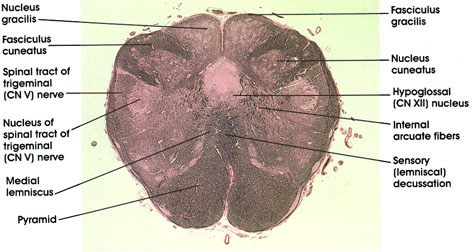

Plate 17.329 Medulla Oblongata
Ronald A. Bergman, Ph.D., Adel K. Afifi, M.D., Paul M. Heidger,
Jr., Ph.D.
Peer Review Status: Externally Peer Reviewed

Human, 10% formalin, Pal-Weigert, 5.6 x.
Nucleus gracilis: Fully developed at this level. Only a small remnant of the fasciculus gracilis caps the nucleus.
Nucleus and fasciculus cuneatus: Note that a definite portion of the fasciculus cuneatus caps the nucleus cuneatus compared with that seen in the adjacent nucleus gracilis. The lightly stained island in the fasciculus cuneatus represents neurons of the accessory (lateral) cuneate nucleus.
Spinal tract and nucleus of trigerninal nerve: Continuation of similar structures seen at more caudal levels.
Medial lemniscus: Formed by the decussating internal arcuate fibers. Constitutes the second-order neurons of the posterior column pathways (fasciculi gracilis and cuneatus and their nuclei), conveying kinesthetic sense and discriminative touch to higher levels of the neuraxis.
Pyramid: Corticospinal fibers descending to decussate at more caudal levels.
Sensory (lemniscal) decussation: Also known as decussation of the medial lemniscus. Internal arcuate fibers cross here to form the contralateral medial lemniscus. Provides an anatomical basis for sensory representation of one half of the body in the contralateral cerebral cortex.
Internal arcuate fibers: Second-order fibers arise from gracile and cuneate nuclei, course in the tegmenturn of the medulla, and cross in the sensory decussation to form the medial lemniscus. They convey the same modalities of sensation as the gracile and cuneate tracts (proprioception, touch, and vibratory sense).
Hypoglossal (CN XII) nucleus: A group of large neurons located in a paramedian position dorsal to the medial lemniscus.
Next Page | Previous Page | Section Top | Title Page
Please send us comments by filling out our Comment Form.
All contents copyright © 1995-2025 the Author(s) and Michael P. D'Alessandro, M.D. All rights reserved.
"Anatomy Atlases", the Anatomy Atlases logo, and "A digital library of anatomy information" are all Trademarks of Michael P. D'Alessandro, M.D.
Anatomy Atlases is funded in whole by Michael P. D'Alessandro, M.D. Advertising is not accepted.
Your personal information remains confidential and is not sold, leased, or given to any third party be they reliable or not.
The information contained in Anatomy Atlases is not a substitute for the medical care and advice of your physician. There may be variations in treatment that your physician may recommend based on individual facts and circumstances.
URL: http://www.anatomyatlases.org/